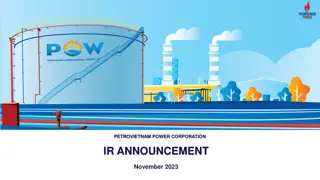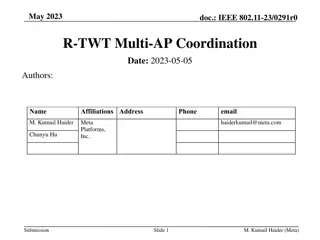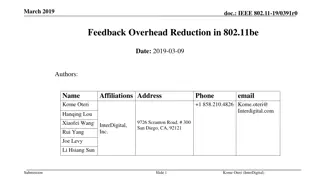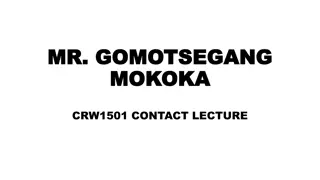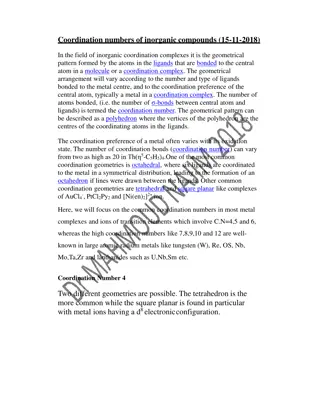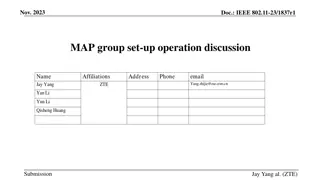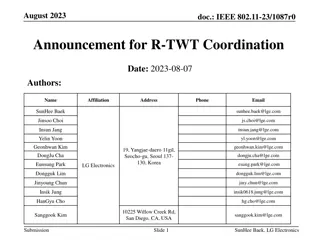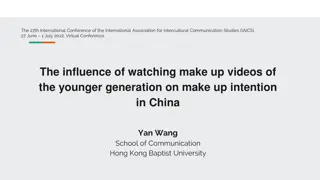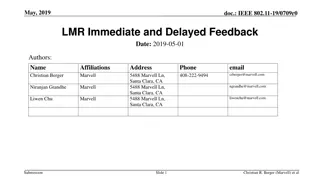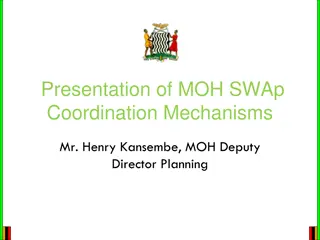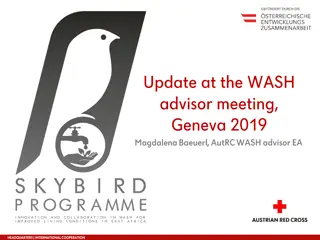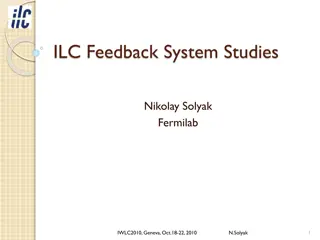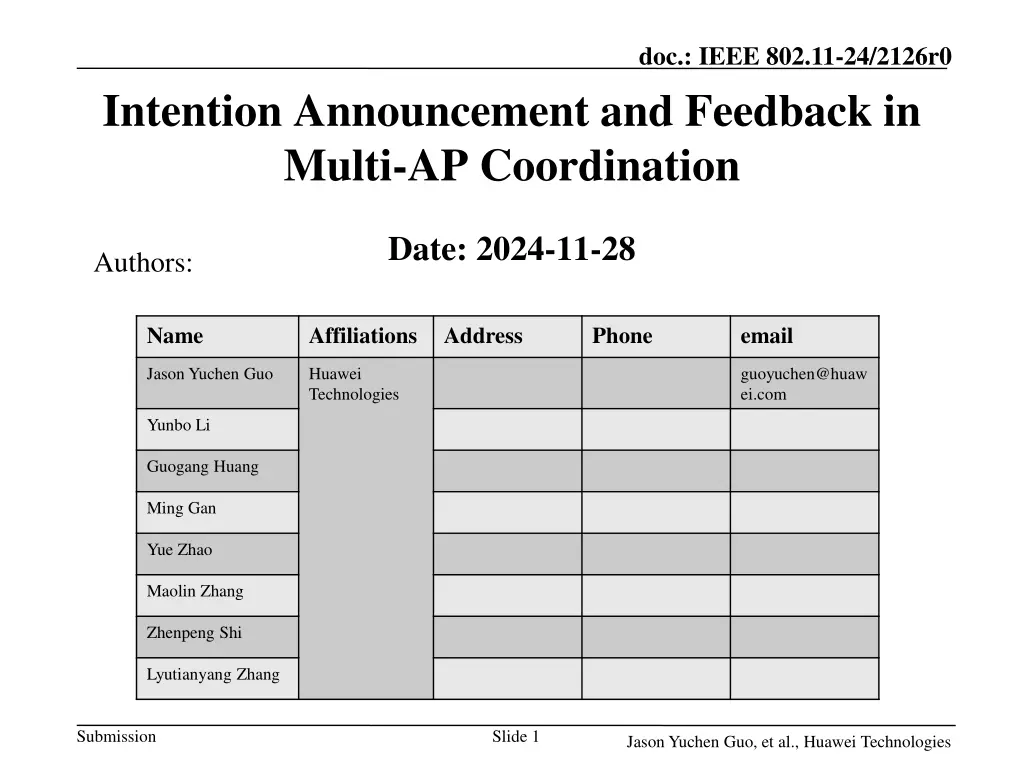
Multi-AP Coordination Procedure for Coordinated TDMA Operation
Explore a detailed procedure in IEEE 802.11-24/2126r0 for APs to announce and coordinate TXOP sharing, including polling, announcement, and response frames. The document discusses the specifics of polling APs for resource requests and announcing decisions to prepare shared data efficiently. Dive into the ICF/ICR exchange mechanism and potential control frame definitions for effective multi-AP coordination in Co-TDMA setups.
Download Presentation

Please find below an Image/Link to download the presentation.
The content on the website is provided AS IS for your information and personal use only. It may not be sold, licensed, or shared on other websites without obtaining consent from the author. If you encounter any issues during the download, it is possible that the publisher has removed the file from their server.
You are allowed to download the files provided on this website for personal or commercial use, subject to the condition that they are used lawfully. All files are the property of their respective owners.
The content on the website is provided AS IS for your information and personal use only. It may not be sold, licensed, or shared on other websites without obtaining consent from the author.
E N D
Presentation Transcript
doc.: IEEE 802.11-24/2126r0 Intention Announcement and Feedback in Multi-AP Coordination Date: 2024-11-28 Authors: Name Affiliations Address Phone email Jason Yuchen Guo Huawei Technologies guoyuchen@huaw ei.com Yunbo Li Guogang Huang Ming Gan Yue Zhao Maolin Zhang Zhenpeng Shi Lyutianyang Zhang Submission Slide 1 Jason Yuchen Guo, et al., Huawei Technologies
doc.: IEEE 802.11-24/2126r0 Introduction TGbn has agreed to define a procedure for a TXOP owner AP to announce its intention of sharing a portion of the time resource of its TXOP for Co-TDMA operation, in an Initial Control frame (exact ICF and name TBD) sent at the beginning of the TXOP. The frame polls AP(s) with whom it may share the TXOP to determine their interest. [1] [Motion #156] A candidate AP that is polled by the sharing AP shall provide, via a response, Its intention not to participate in TXOP sharing during the current TXOP. Note: If the sharing AP doesn t receive a response from a polled AP, it assumes that the polled AP is not interested in TXOP sharing during the current TXOP. Its intention to participate in TXOP sharing during the current TXOP. Signaling details (including traffic indication) are TBD. [1] [Motion #157] In this contribution, we discuss the details of the above procedure. Submission Slide 2 Jason Yuchen Guo, et al., Huawei Technologies
doc.: IEEE 802.11-24/2126r0 Polling & Announcement The purpose of polling frame (from the sharing AP) is to determine whether the polled AP has resource request. This is needed because otherwise the sharing AP does not know which AP to share the resource with. Note-other Multi-AP schemes (e.g., Co-BF, Co-SR) may also need this polling procedure. The purpose of the announcement frame is to advertise the sharing AP s decision so that the shared APs can start preparing the data. The announcement frame and the polling frame should be separate because the decision can only be made after the polling phase. Submission Slide 3 Jason Yuchen Guo, et al., Huawei Technologies
doc.: IEEE 802.11-24/2126r0 Polling & Response The polling & response procedure is also named ICF/ICR exchange between APs BSRP is a good candidate for the ICF since the purpose of the ICF is to check the polled AP s resource need (it s the basic function of BSRP) Note-BSRP is just an example, other frames are also possible Regarding ICR, the current BSR may not be a perfect choice since it only provides the number of bytes in the buffer. However, the CTDMA procedure is a time allocation procedure. Hence, it s better to define a way for the polled AP to report the requested time duration. A new control ID and control field of the A-Control can be defined. The ICR can be QoS Null frame that carries this new control field if the QoS Null frame transmission between APs is allowed, otherwise, we can let the Multi-STA BA frame to carry the new control field. Submission Slide 4 Jason Yuchen Guo, et al., Huawei Technologies
doc.: IEEE 802.11-24/2126r0 Contents in the ICR The following information should be carried in the ICR Requested medium time: the duration that the polled AP requested to be allocated from the sharing AP Scaling factor: the unit of the requested medium time Requested BW: the BW that the polled AP intends to be allocated Note1-the polled AP may have preference on the BW to be used during CTDMA, based on its own/associated STA s capabilities Note2-this will affect the requested medium time. If the allocated BW is smaller than requested BW, then the requested medium time is longer TID/AC: the TID/AC of the buffer Deadline: the expiration time of the buffered data. Submission Slide 5 Jason Yuchen Guo, et al., Huawei Technologies
doc.: IEEE 802.11-24/2126r0 Announcement After the ICF/ICR exchange between the sharing AP and the polled APs, the sharing AP can decide which APs to share the medium time with. The sharing AP can send an announcement frame to all the shared APs, and indicates the following information: The expected transmission starting time of each shared AP The expected allocation duration of each shared AP After the announcement frame, the sharing AP can allocate time resource to each of the shared AP following the MU-RTS TXS procedure. Submission Slide 6 Jason Yuchen Guo, et al., Huawei Technologies
doc.: IEEE 802.11-24/2126r0 Conclusion We discuss the details of the poll and announcement procedure for Multi-AP, especially for the CTDMA The poll/response (ICR/ICR) procedure enables the polled AP to report its resource needs to the sharing AP, and should be time based The announcement procedure indicates the sharing AP s final decision for sharing, and gives shared AP time to prepare for the data transmission. Poll (ICF) and announcement frames should be two different frames. Since resource request is needed for other Multi-AP schemes (e.g., Co-BF, Co-SR), the proposed ICF/ICR details can also be used for them. Submission Slide 7 Jason Yuchen Guo, et al., Huawei Technologies
2023 doc.: IEEE 802.11-24/2126r0 Reference [1] 11-24-0171r20: 11-24-0171-20-00bn-tgbn-motions-list- part-1 Submission Slide 8 Jason Yuchen Guo, et al., Huawei Technologies

